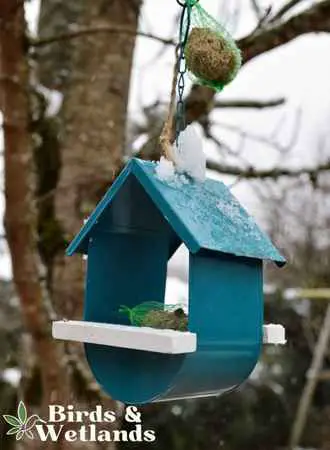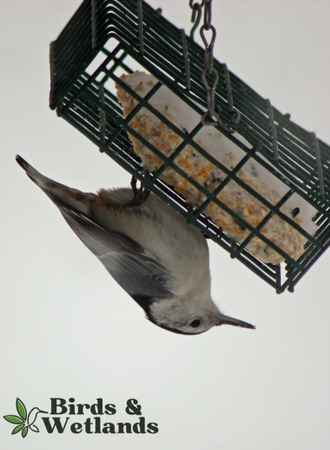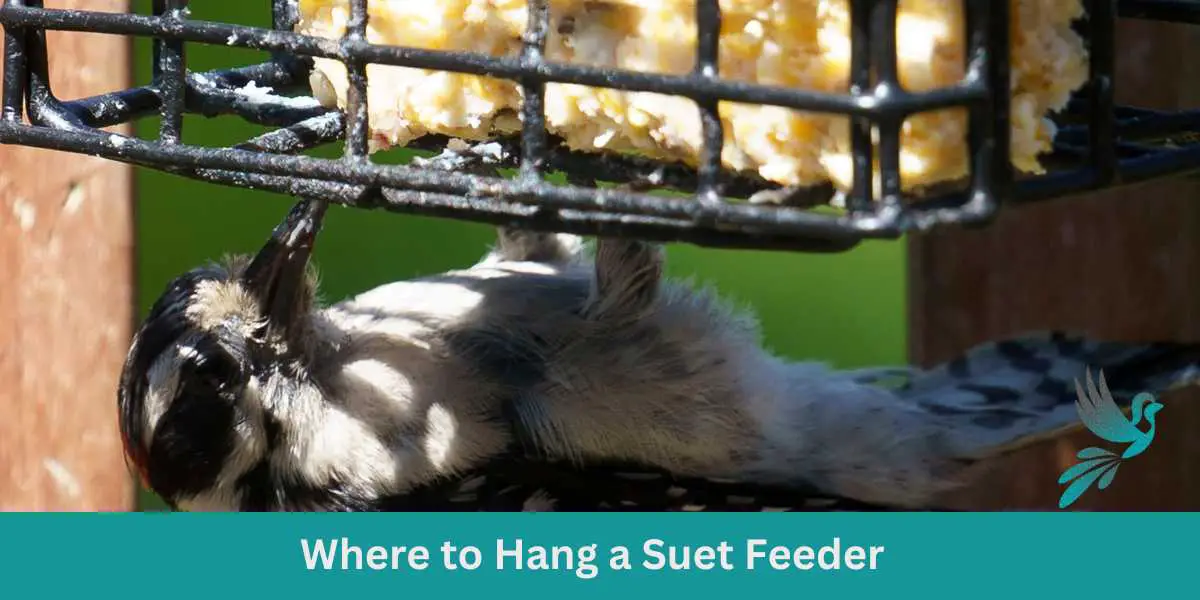If you love watching birds, then you know how important it is to have a suet feeder that will attract them to your backyard. However, choosing the right location for your suet feeder can be tricky. There are a lot of factors to consider, such as safety for the birds, accessibility for you, and how visible the feeder is from different vantage points.
In this blog post, we will guide you through the process of finding the best places to hang your suet feeder, so you can enjoy the company of your feathered friends while sipping your morning coffee or relaxing in your backyard. So, let’s get started and discover the perfect location for your suet feeder.
Key Takeaways on Putting Suet Feeders
- Feeding birds suet is one of the ways you can support local bird populations survive winter. Many birds love suet and they typically feed on them when food is scarce.
- An upside-down suet feeder is a popular choice to offer small clinging birds suet blocks.
- Choosing a safe location for bird feeders can help bird lovers attract more birds to their bird-friendly gardens and backyards.
Where to hang suet feeders?
Suet feeders are a great way to attract garden birds to your backyard and provide them with food during the winter months. However, it’s important to choose the right location to hang your suet feeders to ensure that they are effective and safe for the birds.
Here are some considerations to keep in mind when choosing the best location for your suet feeders.
Accessibility
The first consideration when choosing a location for your suet feeder is accessibility. You want to make sure that the feeder is easily accessible to birds so that they can easily find it and feed from it. Ideally, the feeder should be visible from a distance, so birds can see it while flying overhead.

Protection
The second consideration is protection. You want to ensure your suet feeder is protected from predators like cats, squirrels, and raccoons. You can do this by hanging the feeder from a tree branch or using a squirrel-proof feeder. Also, keep the feeder away from windows, as birds can injure themselves if they fly into them.
Height
You want to hang your suet feeder at a height that is easy for birds to reach but difficult for predators to access. A height of 5-6 feet off the ground is usually ideal.

Distance
Make sure that your suet feeder is not too close to other bird feeders or birdhouses. This can cause territorial disputes among birds and discourage them from using the feeder. It’s best to place the feeder at least 10-15 feet away from other feeders and birdhouses.
Weather Protection
The fifth consideration is weather protection. You want to hang your suet feeder in a location that is protected from the elements, such as wind and rain. This will help prevent the suet from spoiling and ensure the birds have a fresh food supply.

Lighting
The location where you plan to hang your suet feeders should be well-lit, especially during the winter months when daylight hours are limited. This will make it easier for birds to find the feeder and feed from it.
Landscaping
You want to choose a location that is surrounded by trees or shrubs. This will provide suet-eating birds such as the downy woodpecker, pileated woodpecker, tufted titmouse and other birds, with a place to perch and rest between feedings.

How to hang suet without a feeder
If you enjoy watching birds in your backyard, feeding suet can be an excellent way to attract various species. Suet cake is a high-energy food rich in fats and proteins, making it ideal for birds during the colder months when their natural food sources may be scarce.
While cage suet feeders are popular options for offering suet, it is also possible to feed suet to backyard birds without using a bird feeder or suet cages.
Here are some tips for offering suet to birds without a feeder or cage.
Choose a location
The first step is to choose a location where you can offer suet. Look for a spot that is visible from your house but also provides some cover for the birds. A tree branch, for example, can be an ideal location since it provides some protection from predators but also allows the birds to easily access the suet.
Select the right suet
Next, you’ll want to select the right type of suet. Many birds eat suet, so it’s important to choose one that is appropriate for the species of birds that you hope to attract. Look for suet that is specifically formulated for wild birds, as this will typically be free of harmful additives and preservatives.
Offer the suet
Once you have chosen a location and selected the right suet, it’s time to offer the suet. Simply place a chunk of suet in a mesh bag or a piece of netting and tie it securely to the tree trunk or branch. Alternatively, you can spread suet on pine cones, roll it on a sheet filled with bird seed and hang them using a strong or twine.
Make sure that the suet is visible from a distance so that smaller birds can easily spot it.
Keep it fresh
It’s important to keep the suet balls or cakes fresh. Suet can spoil quickly, especially in warm weather, so it’s important to replace it regularly. Check the suet every day or two, and replace it if it appears to be spoiled or if it has attracted insects or other pests.
How to attract birds to suet feeder
If you’re looking to attract birds to your suet feeder, there are a few simple tips you can follow.
- Choose the right location. Birds prefer a safe and quiet location that provides cover from predators. Place suet feeders in a tree or on a pole away from busy areas.
- Use high-quality suet. Birds can be picky eaters. Choose a high-quality suet that is fresh and free from additives. Avoid suet that is rancid or contains fillers.
- Offer a variety of suet flavors. Birds have different preferences when it comes to suet. Offer a variety of flavors such as peanut butter, fruit, or insect-based suet to attract a wider range of bird species.
- Place seed feeders along with other suet feeders to attract different birds to your yard.
- Keep the feeder clean. Dirty feeders can discourage birds from feeding. Clean your suet feeder regularly with hot, soapy water and disinfect it with a mild bleach solution.
- Use a feeder with perches. Some birds prefer to perch while feeding. Choose a feeder with perches to attract these species.
- Provide a source of water. Birds need water for drinking and bathing. Offer a source of fresh water nearby to attract more birds to your suet feeder.
Do birds like upside down suet feeders?
Suet feeders are popular bird feeders designed to hold high-energy bird food from animal fat. These feeders are especially popular among bird watchers who want to attract woodpeckers, nuthatches, and other insect-eating birds to their backyard.
However, some bird enthusiasts wonder if birds like upside-down feeders, designed to hang from a branch or other elevated structure with the suet cakes hanging underneath the feeder.
Many species of birds do like upside-down suet feeders. In fact, some bird enthusiasts prefer these feeders because they are more challenging for squirrels and other mammals to access. This means that birds can feed on the suet without competing with larger animals for their food.
Upside-down suet feeders are particularly popular among woodpeckers, nuthatches and chickadees, known for their ability to cling to trees and other vertical surfaces.
It’s important to note that not all birds will be attracted to suet feeders, regardless of whether they are right-side up or upside down. Some bird species prefer other types of food, such as seeds, fruit, or nectar.

How long does packaged bird suet last?
The shelf life of packaged bird suet varies depending on the storage conditions and the specific product. Generally, bird suet can last for several months up to a year if kept in the freezer away from direct sunlight and heat sources. However, it is best to check the expiration date on the package and consume it before the recommended date.
Additional Tips on How to Offer Birds Suet
- If the suet appears discolored, rancid, or has a foul odor, it is no longer safe to use and should be discarded. Store unused suet
- If you don’t want to buy commercial suet, you can actually make your own suet mix using homemade suet recipes using vegetable shortening, bacon fat or raw suet and corn meal.
- It could take weeks or even months before birds discover your new feeder filled with delicious suet so be patient.
- Using a suet cage helps protect suet-loving birds from larger birds and other wild animals.
- Hanging feeders close to each other is not ideal. It often results in overcrowding and bullying among birds. Make sure you hang your feeders several inches away from each other.
- Diversify your bird food offerings by placing other feeders such as log feeders, hummingbird feeder or hopper feeders.
- Offer birds regular suet during cold weather and no-melt suet once the outdoor temperature begins to rise.
- Avoiding bird window collisions is important so make sure you hang suet plugs and other busy feeders away from windows to avoid birds hitting them.



